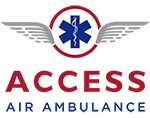At the heart of every professional Air Ambulance mission we conduct are three guiding principals that align with our Mission Statement: Safety Focused Operation, Patient Focused Healthcare and Client Focused Solutions.
- Receiving hospital determines the need for air medical transport either from their own department or from a Community Health Centre after consultation with staff.
- Physician submits medevac request to Med-Response which contacts which place a phone call to our 24/7/365 System Operations Centre (OCC).
- OCC notifies the appropriate on-duty air medical and flight crew (either positioned in Inuvik or Yellowknife) of the medevac mission. The assigned flight and air medical crews begin preparation and report to hangar.
- Pilots check weather and airstrip conditions at pickup and receiving destinations, as well as at least two alternates.
- If safe flying conditions are met the pilots report to OCC that the mission is a “go” and begin flight preparations: file a flight plan, brief medical crew on routing and conditions, calculate and arrange fuel, and prepare aircraft.
- If safe flying conditions are not immediately met, OCC and Med-Response are notified of the reasons and alternate plans discussed. If the alternate plan is to wait for conditions to improve, the medevac is given a “hold” status, conditions monitored and the team waits on stand-by for improved conditions when the mission is deemed a “go”.
- Medical team contacts the sending facility for a patient report. Number of team members, specialized equipment and medications are determined, prepared, loaded and secured.
- Aircraft and crew prepared and briefed, medevac is launched for pickup community.
- Using satellite automated flight-following equipment (SAFE), OCC monitors the flight and communicates updated weather and flight information with the flight crew. Air medical crew communicates with the pickup destination via satellite phone to discuss patient care information and relay ETA.
- Upon arrival the medevac is met by the health center staff and the air medical crew are taken to the health centre, assess and stabilize the patient and prepare them for transport. The patient is transported to the airport, loaded into the aircraft, secured and briefed for flight. The pilots will have received updated weather reports, prepared the aircraft for departure and updated OCC. Final briefing between pilots and medical team complete, the medevac departs for the receiving destination
- Enroute to receiving destination OCC monitors the flight and communicates updated weather and flight information with the flight crew. Air medical crew members care for the patient(s) and, via satellite phone, communicate with Emergency Department Physician at the receiving hospital, update patient status information and relay estimated time of arrival.
- Upon arrival at receiving destination the patient is loaded into a ground ambulance and, along with the air medical crew, transported to the receiving hospital.
- Upon arrival at the receiving hospital, a comprehensive medical report is provided and air medical crew members conduct transfer of care.
- The pilots update OCC on current medevac status and receive further medevac mission instructions.
- Once the air medical team returns, and if no additional medevac missions are immediately in order, the aircraft departs and the team returns home to their original base of operations.
- Any aircraft disinfection, maintenance, restocking of supplies including oxygen, then occurs before the aircraft is re-fueled and placed in line to await the next mission.
